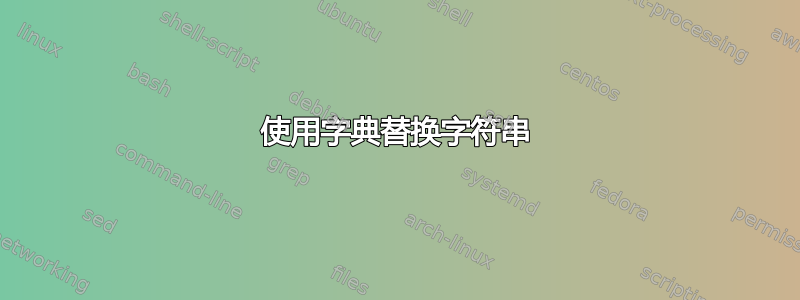
使用字典在文件中进行字符串替换的好方法是什么很多取代端-取代基对?并由很多,我实际上指的是大约 20 个——不多,但足够多,让我想把它们整齐地组织起来。
我有点想以dictionary.txt一种易于管理的方式收集文件中的所有取代端-取代基对,因为我需要替换很多东西,比如:
"yes" : "no"
"stop" : "go, go, go!"
"wee-ooo" : "ooooh nooo!"
"gooodbye" : "hello"
"high" : "low"
"why?" : "i don't know"
现在我想在某个文件中应用这些替换novel.txt。
然后我想运行magiccommand --magicflags dictionary.txt novel.txt,以便yesin的所有实例novel.txt都被替换no(因此 EvenBayesian会被替换),并且inBanoian的所有实例都将被替换,依此类推。goodbyenovel.txthello
到目前为止,我需要替换(和替换)的字符串是不是其中有任何引号(既不是单引号也不是双引号)。 (当然,如果能看到一个能够很好地处理包含引号的字符串的解决方案那就太好了。)
我知道sed并且awk/gawk主要可以做这样的事情,但是它们也可以使用这样的字典文件吗?看起来好像gawk会是合适的人选magiccommand,合适的人选有哪些呢magicflags?我需要如何格式化我的dictionary.txt?
答案1
这里有一种方法sed:
sed '
s|"\(.*\)"[[:blank:]]*:[[:blank:]]*"\(.*\)"|\1\
\2|
h
s|.*\n||
s|[\&/]|\\&|g
x
s|\n.*||
s|[[\.*^$/]|\\&|g
G
s|\(.*\)\n\(.*\)|s/\1/\2/g|
' dictionary.txt | sed -f - novel.txt
它是如何工作的:
第一个sed变成dictionary.txt一个脚本文件(编辑命令,每行一个)。这通过管道传输到执行这些命令的第二个sed(注意,这-f -意味着从 读取命令stdin),编辑novel.txt。
这需要翻译您的格式
"STRING" : "REPLACEMENT"
进入sed命令并转义过程中的所有特殊字符LHS和RHS:
s/ESCAPED_STRING/ESCAPED_REPLACEMENT/g
所以第一次替换
s|"\(.*\)"[[:blank:]]*:[[:blank:]]*"\(.*\)"|\1\
\2|
变成(是换行符) "STRING" : "REPLACEMENT"。然后将结果复制到旧空间。删除第一部分,仅保留然后转义保留字符(这是)。 然后,它使用模式空间更改保持缓冲区,并删除仅保留的第二部分并进行转义(这是)。 然后,保持缓冲区的内容通过 附加到模式空间,因此现在模式空间内容为。 最终换人STRING\nREPLACEMENT\nh
s|.*\n||REPLACEMENTs|[\&/]|\\&|gRHSxs|\n.*||STRINGs|[[\.*^$/]|\\&|gLHSGESCAPED_STRING\nESCAPED_REPLACEMENT
s|\(.*\)\n\(.*\)|s/\1/\2/g|
将其转化为s/ESCAPED_STRING/ESCAPED_REPLACEMENT/g
答案2
这是一个 perl 版本。它创建一个包含预编译正则表达式的哈希,然后循环遍历每行输入,将所有正则表达式应用到每一行。 perl's-i用于输入文件的“就地编辑”。您可以轻松添加或更改任何正则表达式或替换字符串。
使用预编译正则表达式qr//大大提高了脚本的速度,如果有大量正则表达式和/或大量输入行需要处理,这将非常明显。
#! /usr/bin/perl -i
use strict;
# the dictionary is embedded in the code itself.
# see 2nd version below for how to read dict in
# from a file.
my %regex = (
qr/yes/ => 'no',
qr/stop/ => 'go, go, go!',
qr/wee-ooo/ => 'ooooh nooo!',
qr/gooodbye/ => 'hello',
qr/high/ => 'low',
qr/why\?/ => 'i don\'t know',
);
while (<>) {
foreach my $key (keys %regex) {
s/$key/$regex{$key}/g;
}
}
这是另一个版本,它从命令行上的第一个文件名读取字典,同时仍然处理第二个(以及可选的后续)文件名:
#! /usr/bin/perl -i
use strict;
# the dictionary is read from a file.
#
# file format is "searchpattern replacestring", with any
# number of whitespace characters (space or tab) separating
# the two fields. You can add comments or comment out dictionary
# entries with a '#' character.
#
# NOTE: if you want to use any regex-special characters as a
# literal in either $searchpattern or $replacestring, you WILL
# need to escape them with `\`. e.g. for a literal '?', use '\?'.
#
# this is very basic and could be improved. a lot.
my %regex = ();
my $dictfile = shift ;
open(DICT,'<',$dictfile) || die "couldn't open $dictfile: $!\n";
while(<DICT>) {
s/#.*// unless (m/\\#/); # remove comments, unless escaped.
# easily fooled if there is an escaped
# '#' and a comment on the same line.
s/^\s*|\s*$//g ; # remove leading & trailing spaces
next if (/^$/) ; # skip empty lines
my($search, $replace) = split;
$regex{qr/$search/} = $replace;
};
close(DICT);
# now read in the input file(s) and modify them.
while (<>) {
foreach my $key (keys %regex) {
s/$key/$regex{$key}/g;
}
}
答案3
开始将其写为评论,但它变得太复杂,因此有第二个 perl 答案。给定你的源文件,你可以使用一个简洁的 perl 技巧来构建一个正则表达式:
#!/usr/bin/env perl
use strict;
use warnings;
use Data::Dumper;
#build key-value pairs
my %replace = map { /"(.+)"\s*:\s*"(.+)"/ } <DATA>;
print Dumper \%replace;
#take the keys of your hash, then build into capturing regex
my $search = join ( "|", map {quotemeta} keys %replace );
$search = qr/($search)/;
print "Using match regex of: $search\n";
#read stdin or files on command line, line by line
while ( <> ) {
#match regex repeatedly, replace with contents of hash.
s/$search/$replace{$1}/g;
print;
}
__DATA__
"yes" : "no"
"stop" : "go, go, go!"
"wee-ooo" : "ooooh nooo!"
"gooodbye" : "hello"
"high" : "low"
"why?" : "i don't know"
我们使用多行模式匹配生成哈希并map创建键值对。
我们构建一个搜索正则表达式,并使用其中捕获的值进行替换。
使用的<>是 perl 的神奇文件句柄 -STDIN或在命令行上指定的文件。 sed 是如何做到这一点的。 (您可以使用一个文件并“正常”读取它的模式,使用DATA纯粹是说明性的)。


